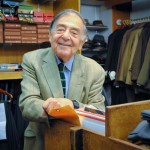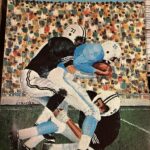 Lord Of New York may sound like a comic-book villain, but it’s actually a lesser-known Ivy haberdasher.
Lord Of New York may sound like a comic-book villain, but it’s actually a lesser-known Ivy haberdasher.
It came up in conversation at a Paul Stuart event recently with a fellow who sells menswear on eBay under the username mack11211. Mack told me about a few bespoke Lord suits made in 1963 he has for sale.
The firm is mentioned in George Frazier’s seminal essay “The Art of Wearing Clothes.” Here’s a passage that explains the origins of Lord Of New York as well as serving as a kind of family tree of Ivy haberdashers:
Lord of New York is brash, explorative, and highly disorganized. Chronologically, Lord of New York is a branch of a genealogy that goes all the way back to 1835 and Brooks Brothers’ natural-shoulder — or, as it is precisely known, No. 1-sack suit. Around the turn of the century, Arthur Rosenberg, then the foremost tailor in New Haven, began to exploit this style among Yale undergraduates, and, not long afterwards, J. Press, also of New Haven, fell into line. Eventually, two Rosenberg employees, Sam Rosenthal and Moe Maretz, went out on their own as Rosenthal-Maretz; then Bill Fenn and Jack Feinstein left David T. Langrock to form Fenn-Feinstein (now associated with Frank Brothers). Somewhat later on, Mort Sill and (a year later) Jonas Arnold quit Press and opened a shop in Harvard Square, Cambridge, which they called Chipp. Then, with his partner’s departure to form Sill (New York and Harvard Square), Jonas Arnold entered into an agreement whereby two former Press employees — Sid Winston and the late Lou Prager — were permitted to use Chipp as the name of the shop they were about to open in New York. Arnold, who closed his Cambridge store several years ago, is still a partner in the New York Chipp’s. In 1952, Lord of New York was begat by Chipp — or, more accurately, by three of its former employees, Ken Frank, Mike Fers, and Peter D’Annunzio. Lord charges $195 and up for a two-piece hand-stitched suit lined with tie silk. Unlike Chipp, it neither charges extra for open buttonholes on jacket sleeves nor does it line coat collars with foulard. Unlike J. Press, it resists such gimmicks as lining the breast pocket of a jacket with foulard that can be turned inside-out to serve as a handkerchief.
And while we’re at it, here’s Frazier on Norman Hilton, The Andover Shop, and Brooks Brothers:
It could hardly have been otherwise, for nowadays even the smallest town has a men’s shop that carries the same suits and haberdashery that are on sale at, say Madison Avenue and Forty-fifth Street in New York. New Bedford, Massachusetts, for example, has Marty Sullivan’s, a store so attuned to the fickleness of fashion that it has its buyers and designers spend part of their Manhattan visitations in such bars-and-grills as P. J. Clarke’s, which attracts an extremely creatively-dressed Ivy League clientele. Furthermore, shops like Sullivan’s-Eddie Jacobs’ in Baltimore; Dick Carroll’s in Los Angeles; and, in New York, Casual-aire, Paul Stuart’s, Phil’s, to name a few — are far from expensive. What’s more, at their best-Atkinson’s in Los Angeles and Pasadena, California, and the Andover Shops in Cambridge and Andover, Massachusetts, which derive much of their appeal from the superb workmanship of Frank Spade, the head tailor, and the creativeness of co-owner, Charles Davidson — they are superlatively tasteful. Even in 1960, however, not all ready-made suits are low-priced. Oxxford, for example, turns out a suit that costs $235 and up, is impeccably tailored, and has a following among affluent men who are either too impatient to hold still for custom fittings or dislike investing in a garment without knowing how it will look when finished. From the point of view of style, the best ready-made American suit is turned out by Norman Hilton, a young, enterprising, and discerning Princeton alumnus who, among other things, makes blazers and sports coats for Brooks Brothers. (Contrary to prevalent opinion, Brooks Brothers does not manufacture all its wares, but has certain items made to its specifications and on its own models. Only the label “Brooks Brothers Makers” means a Brooks-manufactured garment.)
Although Brooks Brothers (which also goes in for custom clothes) can no longer be regarded as the unique pace-setter it was prior to the recent renaissance of interest in men’s clothes, it still carries come matchless items, notably its neckwear and shirts, particularly its white buttondown in Pima broadcloth, which costs $8.50 and, among ready-made shirts, is in a class by itself.
The final word comes from our columnist Richard Press:
Lord was run by Ken Cohen, former Chipp road traveler, and Pete D’Annunzio, former fitter at Chipp. They were situated in the same building upstairs from J. Press in NYC and had a small but significant Racquet Club-type of following, similar to custom tailors Morty Sills and Rosenthal-Maretz.
Richard, incidentally, will be answering reader questions in a special post going up on Monday, souse the weekend to imagine what you’d like to ask the grandson of J. Press, who worked at the company during the good old days. — CC











Great research Christian. Interesting post.
I saw the Lord suits MACK11211 put up on ebay a while ago. My initial thought was how few people would recognize the name or their quality.
C.-Looking forward to seeing the article on Charlie.
Great piece Christian. I love learning about this kind of stuff.
well done .
max–
Other than Kilgour, none of these exist today. Weatherill exists in London as part of Huntsman. BB has no bespoke department, only MTM-a far cry from what it was.
I came across your article when randomly searching the Internet for information on my father’s shop. Ken Cohen (also known as Ken Frank) was my father. As a young girl, I made many trips to Lord of New York. I still remember the beautiful bolts of fabric
As an fyi for your readers, my father made suits for Walter Matthau, Mike Wallace, Hubert Humphrey, John Davidson, Zero Mostel, and those are just the ones I remember. Thank you so much for this piece. It has brought back so many fond memories for me. I had no idea anyone even remembered Lord of New York.
Michele, tell us more! Finally, some talk about…clothes!!!
I don’t know how I stumbled across this piece but Peter D’Annunzio of Lord of New York was my grandfather. I loved visiting that shop and remember seeing Henry Kissinger getting fitted for his suits and hearing of the many actors that came in as well. I to this day have may ties hanging in my closet that my grandfather made With the Lord of New York label.
The article about Lord of New York and its genealogy from its’ New Haven roots is a
veritable Almanach de Gotha of mens traditional clothing. Conspicuously missing is
Dunhill Tailors, another star in the New York menswear firmament. No doubt because
there was no New New Haven connection. Here’s a brief description I wrote in Ask
Andy’s about 15 years ago:
A wonderful store. In RTW they featured several models
which were basically a hybrid Saville Row/ Ivy League
look, eg. side vents but natural shoulders. I got a summer
suit there in the early 80s …
very elegant and distinctive. I still have
some of their shirts which look stylish 20 years later. No one
has mentioned , but I recall that their furnishings department
was staffed by delicious young females, a apt counterpoint
to the otherwise clubby atmosphere. After their purchase
by Dunhill ( Tobacco,etc.) the Manhattan store still claimed
to have the MTM and Bespoke service of the original
Dunhill Tailors. Into the 90s this store did have try-ons
of the Dunhull Tailors models. This service was not available
in the San Francisco store.
I wonder–did all of these men envision a future when/where the traditional good taste would be(come) the unofficial copyright of a select, self-chosen few? Surely some of them did–and, looking into the Ivy crystal-ball, hazarded an educated guess that “one day, clothes of this sort will be once again be custom.”
Here we are. Nowadays we use other phrases–“made to order,” “made to measure.”
The scoop remains unscooped by CC. Here’s another hint: With the sad shuddering of Grieco Bros./Southwick, another great American manufacturer will supply the likes of J. Press and O’ Connell’s with tailored natural shoulder clothing. As well as a few other retailers.
All roads lead (back) to Rochester.
I live about two hours from NYC. Would love a visit to J. Press, recently opened, but post-riots, looting, and destruction, and given what appears to be a very fragile atmosphere at present, is the city safe?
‘shuttering,’ rather.
Fyi. Chipp was named for Morty Sills ‘ first wife (Chipp was her nickname). He founded Chipp and his name was Sills not Sill. He was THE tailor to Wall Street. BTW, who now owns the Morty Sills brand? Was it sold by his son Josh?